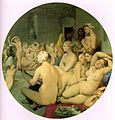| |
让·奥古斯特·多米尼克·安格尔(Jean Auguste Dominique Ingres,1780年8月29日-1867年1月14日)是法国画家,新古典主义画派的最后一位领导人,他和浪漫主义画派的杰出代表欧仁·德拉克罗瓦之间的著名争论震动了整个法国画坛。
安格尔的画风线条工整,轮廓确切,色彩明晰,构图严谨,对后来许多画家如德加、雷诺阿、甚至毕加索都有影响。
生平
安格尔出生于法国南部加龙河上游的塔恩-加龙省首府蒙托邦,父亲是一位肖像画家和音乐家,是他的艺术启蒙教师,1791年他入图卢兹学院学习绘画;1797年到巴黎进入古典主义画派的主要代表人雅克-路易·大卫的画室;1799年考入美术学院油画系;1801年获一等罗马奖;1806年到罗马设画室,创作了大量的作品;1820年迁到佛罗伦萨,接受了大批肖像画的订作;1824年回到巴黎,立即获得很高荣誉;1825年被选为法兰西学院院士;1829年任美术学院院长;1835年再次回到罗马,创作了一系列肖像素描和油画;1841年回巴黎,继续创作多幅巨作。
安格尔一生最崇拜拉斐尔和古代大师,直到87岁高龄还在研究拉斐尔的作品,其最后一件作品就是根据乔托的构图画的。他的主要作品有《土耳其浴女》、《泉》、《路易十三世的宣誓》、《奥德利斯克与奴隶》以及一系列肖像画和大量的素描,还有类似中国画白描的只用线描钩轮廓的作品。
安格尔的声誉如日中天时,也正是古典主义面临终结,浪漫主义崛起的时代,他和新生的浪漫主义代表人德拉克罗瓦之间发生许多次辩论,浪漫主义强调色彩的运用,古典主义则强调轮廓的完整和构图的严谨,安格尔把持的美术学院对新生的各种画风嗤之以鼻,形成学院派风格。
安格尔生前享有很大的声誉,死后安葬在巴黎著名的拉雪兹神父公墓。
画廊
Jean-Auguste-Dominique Ingres (/ˈæŋɡrə, ˈæ̃ɡrə/ ANG-grə, French: [ʒɑ̃ oɡyst dɔminik ɛ̃ɡʁ]; 29 August 1780 – 14 January 1867) was a French Neoclassical painter. Ingres was profoundly influenced by past artistic traditions and aspired to become the guardian of academic orthodoxy against the ascendant Romantic style. Although he considered himself a painter of history in the tradition of Nicolas Poussin and Jacques-Louis David, it is his portraits, both painted and drawn, that are recognized as his greatest legacy. His expressive distortions of form and space made him an important precursor of modern art, influencing Picasso, Matisse and other modernists.
Born into a modest family in Montauban, he travelled to Paris to study in the studio of David. In 1802 he made his Salon debut, and won the Prix de Rome for his painting The Ambassadors of Agamemnon in the tent of Achilles. By the time he departed in 1806 for his residency in Rome, his style—revealing his close study of Italian and Flemish Renaissance masters—was fully developed, and would change little for the rest of his life. While working in Rome and subsequently Florence from 1806 to 1824, he regularly sent paintings to the Paris Salon, where they were faulted by critics who found his style bizarre and archaic. He received few commissions during this period for the history paintings he aspired to paint, but was able to support himself and his wife as a portrait painter and draughtsman.
He was finally recognized at the Salon in 1824, when his Raphaelesque painting of the Vow of Louis XIII was met with acclaim, and Ingres was acknowledged as the leader of the Neoclassical school in France. Although the income from commissions for history paintings allowed him to paint fewer portraits, his Portrait of Monsieur Bertin marked his next popular success in 1833. The following year, his indignation at the harsh criticism of his ambitious composition The Martyrdom of Saint Symphorian caused him to return to Italy, where he assumed directorship of the French Academy in Rome in 1835. He returned to Paris for good in 1841. In his later years he painted new versions of many of his earlier compositions, a series of designs for stained glass windows, several important portraits of women, and The Turkish Bath, the last of his several Orientalist paintings of the female nude, which he finished at the age of 83.









